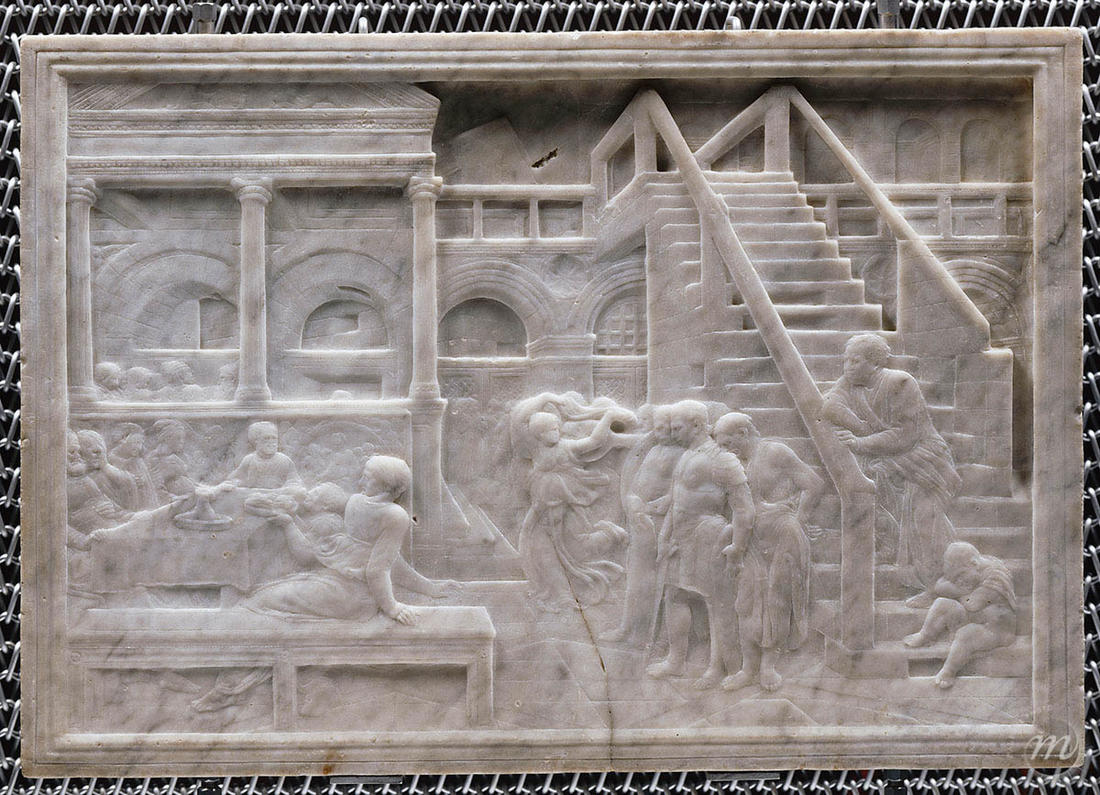In this work, Donatello, one of the greatest Renaissance sculptors, used the rilievo stiacciato (flattened relief) technique that he himself invented. Carving to a depth of less than one centimetre, he evoked a number of skilfully sculpted planes, in some cases barely suggesting them. Using the principles of perspective set out by Leon Battista Alberti in his treatise De Pictura (1435), he composed a scene inspired by classical architecture and based on a painstaking system of vanishing lines, in order to give the illusion of depth.
Against this meticulously detailed background, the narrative plays out in two scenes. They illustrate two episodes in the life of Saint John the Baptist, the saint who baptised Jesus Christ. John the Baptist was imprisoned after condemning the incestuous marriage of King Herod Antipas to his sister-in-law Herodias. On the left we see Salome, daughter of Herodias, dancing for the guests at a banquet. Impressed, the king offers her whatever she desires in reward. On her mother's advice, she asks for the saint's head. The tragic ending is depicted on the right: John the Baptist's head is presented to the king in the presence of Salome, who turns away from the tragedy she herself has caused!
We do not know what function this religious work served. It was probably commissioned by Cosimo de' Medici (1389-1464), the most powerful man in the Republic of Florence and a great art lover. It was listed among his grandson Lorenzo the Magnificent's assets in 1492.
The people's expressions allow viewers to understand what is happening and feel the emotion. Herodias recoils, emphasising the horror of the scene.
Donatello was able to create almost imperceptible gradations in the background relief: so many details escape the eye at first glance.
Inv. Pl 1912

In this work, Donatello, one of the greatest Renaissance sculptors, used the rilievo stiacciato (flattened relief) technique that he himself invented. Carving to a depth of less than one centimetre, he evoked a number of skilfully sculpted planes, in some cases barely suggesting them. Using the principles of perspective set out by Leon Battista Alberti in his treatise De Pictura (1435), he composed a scene inspired by classical architecture and based on a painstaking system of vanishing lines, in order to give the illusion of depth.
Against this meticulously detailed background, the narrative plays out in two scenes. They illustrate two episodes in the life of Saint John the Baptist, the saint who baptised Jesus Christ. John the Baptist was imprisoned after condemning the incestuous marriage of King Herod Antipas to his sister-in-law Herodias. On the left we see Salome, daughter of Herodias, dancing for the guests at a banquet. Impressed, the king offers her whatever she desires in reward. On her mother's advice, she asks for the saint's head. The tragic ending is depicted on the right: John the Baptist's head is presented to the king in the presence of Salome, who turns away from the tragedy she herself has caused!
We do not know what function this religious work served. It was probably commissioned by Cosimo de' Medici (1389-1464), the most powerful man in the Republic of Florence and a great art lover. It was listed among his grandson Lorenzo the Magnificent's assets in 1492.
The people's expressions allow viewers to understand what is happening and feel the emotion. Herodias recoils, emphasising the horror of the scene.
Donatello was able to create almost imperceptible gradations in the background relief: so many details escape the eye at first glance.
Inv. Pl 1912